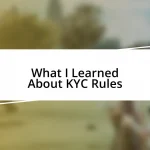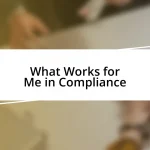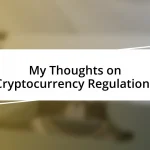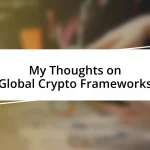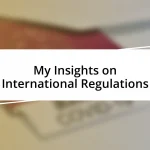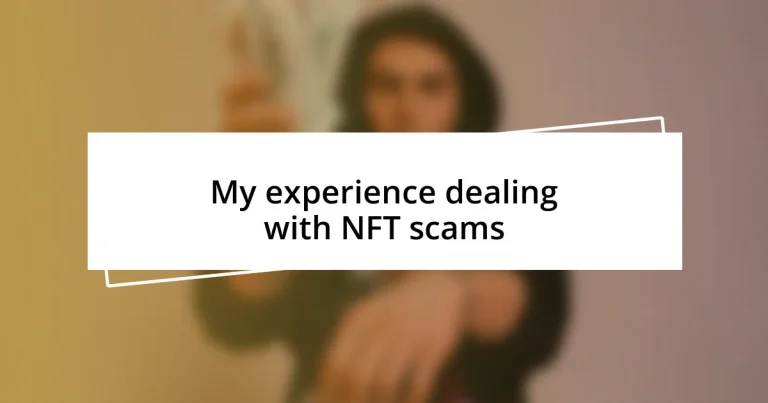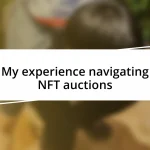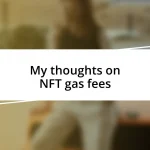Key takeaways:
- Recognizing red flags such as lack of transparency, aggressive marketing, and pressure to invest quickly is critical in avoiding NFT scams.
- Conducting thorough research, checking community sentiment, and implementing security measures can help protect against scams in the NFT space.
- Sharing experiences and reporting scams can raise awareness and foster community support, making it a collective effort to combat NFT fraud.
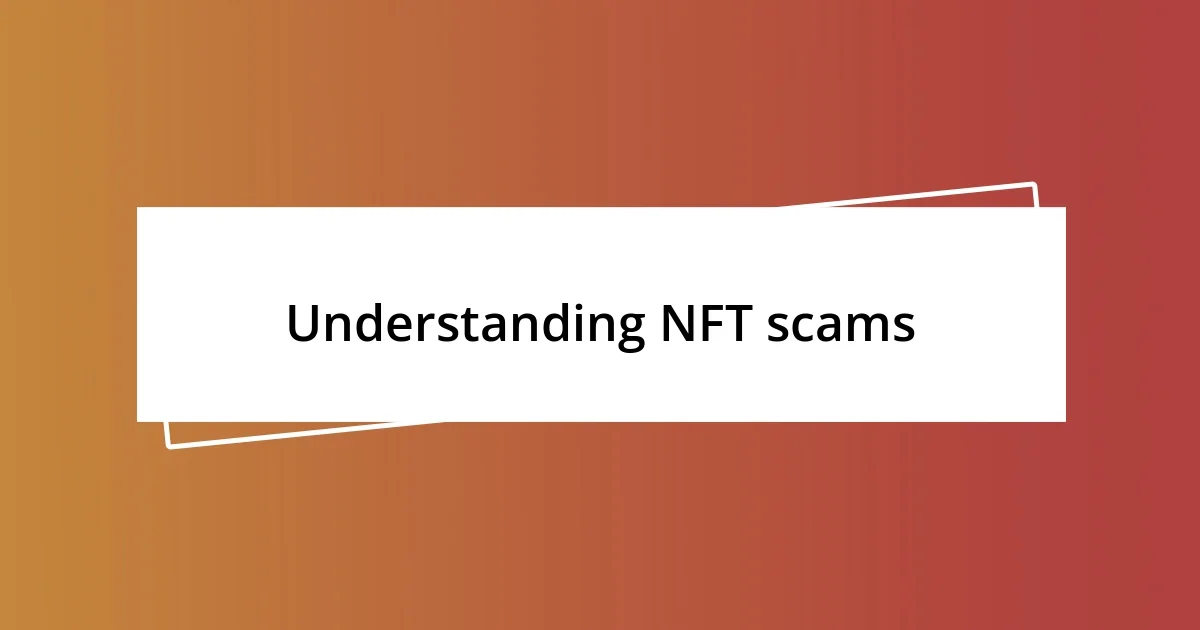
Understanding NFT scams
Understanding NFT scams can be quite overwhelming. I remember the first time I encountered a so-called “exclusive NFT drop” that promised incredible returns. The excitement was palpable, but a nagging feeling lingered—was this too good to be true?
As I dug deeper, I discovered that many scams thrive on creating urgency and exclusivity. For instance, I stumbled upon a fake marketplace that looked strikingly similar to a legitimate one. The realization hit me hard: scammers are skilled at mimicking trusted platforms to exploit our desires.
It’s unsettling to think that anyone can fall victim to these schemes—especially when the allure of digital art and crypto wealth dangles in front of us. Have you ever experienced that thrill of a seemingly great investment, only to find out it was a façade? Reflecting on my journey, it highlights the importance of due diligence and skepticism in this vibrant but risky marketplace.
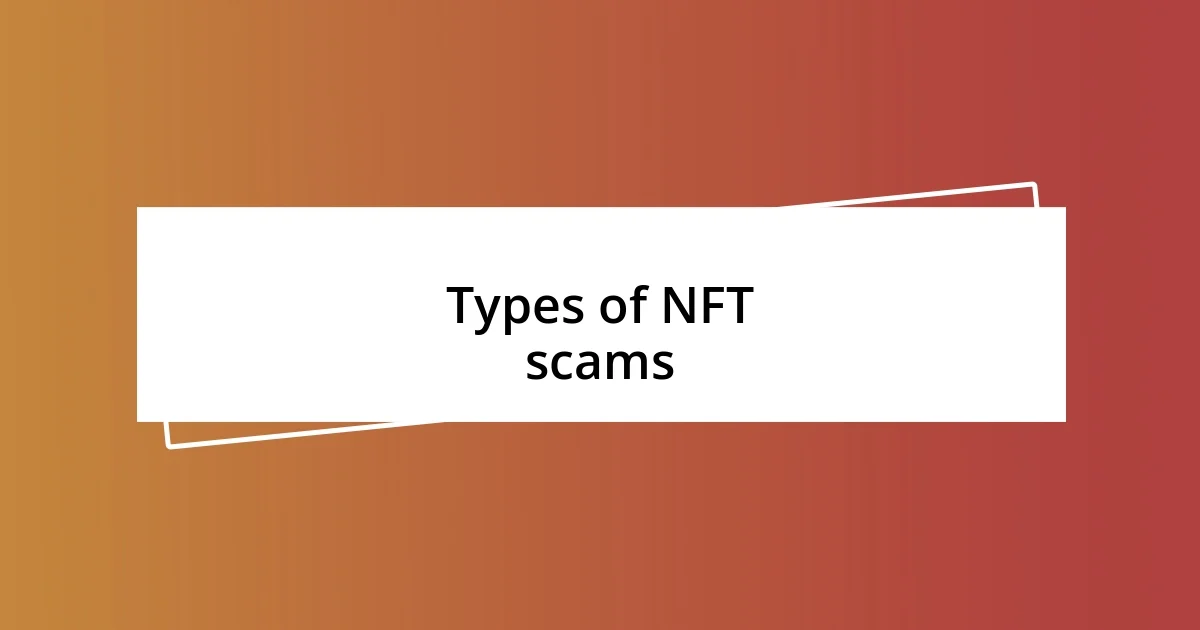
Types of NFT scams
I’ve come across various types of NFT scams that cleverly exploit people’s excitement about digital assets. One particularly devious scheme involved fake celebrity NFTs; scammers created whole websites showcasing supposed exclusive artworks from famous artists, leading many fans to invest their hard-earned money. It was disheartening to see so many people fall for these deceptive ploys, all while believing they were buying the next big thing in art.
Here are some common types of NFT scams to watch out for:
- Phishing scams: These scams often use fake emails or websites to steal your private information or digital wallets.
- Fake marketplaces: Scammers create site designs that mimic real marketplaces to trick users into making purchases that never result in actual NFTs.
- Pump-and-dump schemes: Scammers artificially inflate the value of an NFT, then sell it off, leaving unsuspecting buyers with worthless digital assets.
- Rug pulls: This happens when developers abandon a project after raising funds, taking investors’ money with them into the ether.
- Counterfeit NFTs: Some scams involve selling NFTs that are copied or not genuinely owned by the seller.
Each of these types highlights a larger concern: the need for vigilance. Reflecting on my experiences, I’ve learned that skepticism can be an investor’s best friend in this burgeoning digital art landscape.
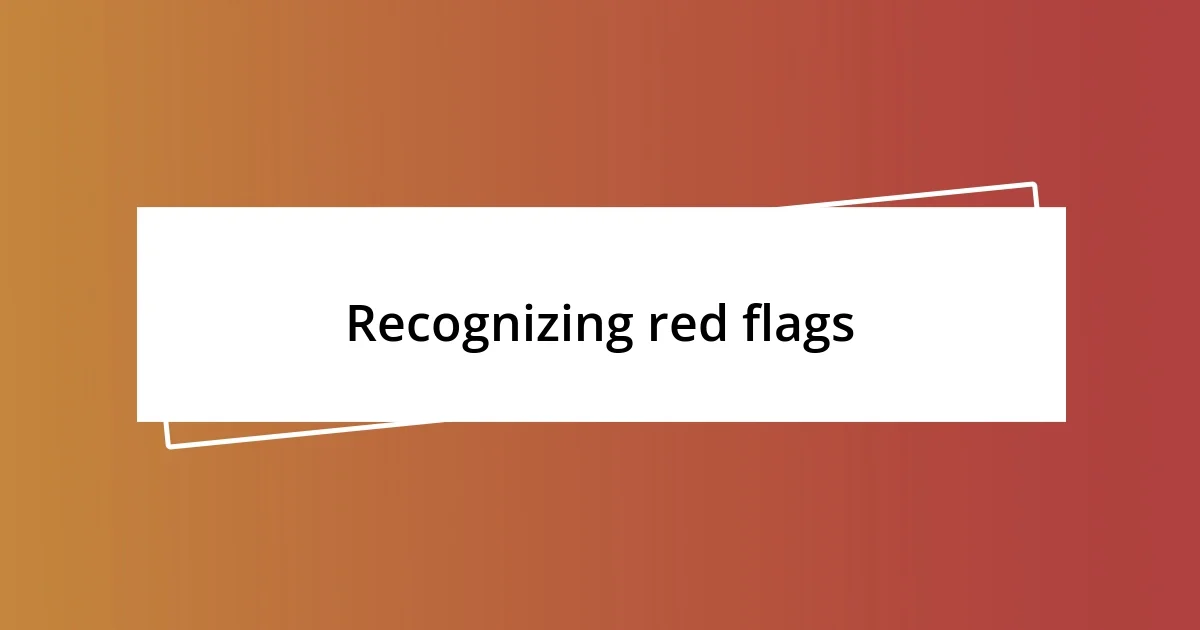
Recognizing red flags
Recognizing red flags in the NFT space is essential. One of the most telling signs is a lack of transparency. For instance, I once came across a project that promised staggering returns but kept its team members shrouded in secrecy. I couldn’t shake off the feeling that if they weren’t willing to reveal who was behind the veil, it was likely a scheme to take advantage of unsuspecting investors.
Another red flag is overly aggressive marketing. I remember feeling overwhelmed by a barrage of social media ads for an NFT collection that seemed to pop up everywhere. The messaging was relentless and sensational, promising unbelievable profits. This made me pause. In my experience, genuine projects don’t need to resort to high-pressure tactics to draw interest. That constant push can indicate desperation, often employed by scammers hoping to lure in quick cash before disappearing.
I’ve also learned to be wary of projects that pressure you into investing quickly. Whenever I see language like “limited-time offer” or “only a few left,” I ask myself, “Why the rush?” This urgency often serves to cloud judgment. Reflecting on my own missteps, embracing a more cautious approach helped me make clearer, more informed decisions in my NFT journey.
| Red Flag | Description |
|---|---|
| Lack of Transparency | Unidentified team members or vague project details. |
| Overly Aggressive Marketing | Constant bombardment of promotional messages and hype. |
| Pressure to Invest Quickly | Language suggesting limited availability or time-sensitive offers. |

How I got scammed
I remember the day it happened all too clearly. I had spotted a vibrant, eye-catching NFT of a digital landscape that felt like a dream come to life. The website looked polished, and the community was abuzz with excitement. I let my enthusiasm cloud my judgment, diving in without proper research. Only later did I discover it was a cleverly disguised counterfeit, leaving me feeling sick to my stomach.
As I delved deeper into the NFT world, I was drawn in by a new collection that promised exclusive access to virtual art exhibits. The language was so enticing—“Once in a lifetime!” they proclaimed. I was swept up in the potential. Little did I know, I was engaging with a marketplace that had already vanished by the time I finished my transaction. The harsh realization hit me: I had been blinded by the thrill, ignoring the gut feeling that something was off.
What stung the most was the aftermath. I watched helplessly as my investment vanished, realizing that I hadn’t protected myself. It made me question, how could I have missed the signs? This traumatic experience taught me a crucial lesson about due diligence and the importance of trusting my instincts in the seemingly glittery yet treacherous realm of NFTs. It’s a harsh lesson, but one I carry with me every day in this digital landscape.

Steps to avoid scams
When navigating the NFT space, it’s imperative to conduct thorough research before investing. I can’t stress enough how often I’ve seen seemingly amazing projects crumble upon closer inspection. A few minutes spent on verifying the team’s identities or exploring their previous works can save you from future heartache. Has anyone else noticed how one or two red flags can often lead to a monumental misstep?
Another technique I’ve opted for is checking community sentiment. I often found myself lurking in forums or social media groups where enthusiasts gather. Listening to the conversations can reveal a lot. For example, if countless people are expressing doubts or sharing negative experiences, it’s a clear warning sign. Don’t you think it’s better to be part of a community that promotes open discussion rather than one that silences dissent?
I’ve also learned to install extra security measures around my digital wallet. Initially, I didn’t think much about it, assuming my existing protections were enough. However, I soon discovered that even the most enticing NFT can come with risks if your wallet isn’t secure. Two-factor authentication and unique passwords became my new best friends. It raised a question for me: why play it safe when there’s so much at stake?
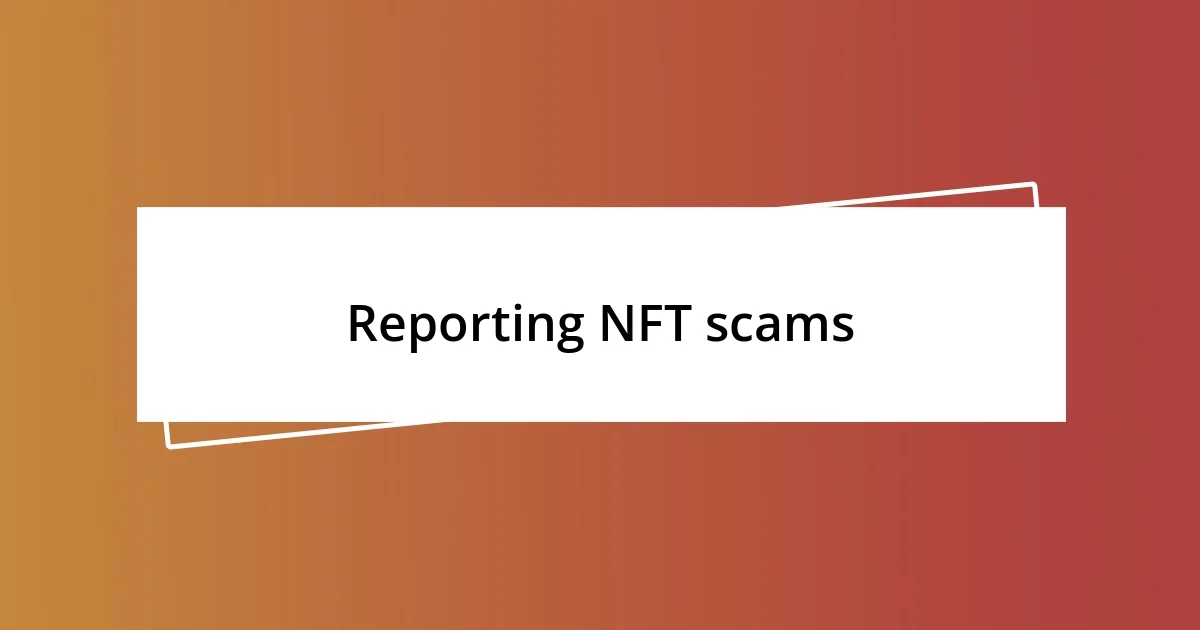
Reporting NFT scams
When it comes to reporting NFT scams, I realized that the first step is knowing where to turn. After my experience, I felt a mix of frustration and urgency to try to prevent others from falling victim. My first action was to report the scam on the platform where I made the purchase. The process was straightforward, but I nonetheless felt a sense of helplessness—did anyone really care about a digital art piece that vanished into thin air?
I also learned that it’s crucial to notify the wider community about these scams. I took to social media and shared my experience, hoping to alert others. It felt empowering to share my story, yet I couldn’t shake the anxiety of wondering if my voice would truly reach those who needed it most. Do you ever feel that, despite your best efforts, you might be shouting into the void?
Additionally, I found filing a report with local authorities and relevant online platforms to be essential. While I was skeptical about what action they would take, sharing my experience with law enforcement validated my feelings of loss and outrage. In the end, knowing I contributed to a larger awareness about NFT scams helped me feel less isolated in my experience. Have you ever felt that reporting can be a form of reclaiming your narrative?

Lessons learned from my experience
One of the most significant lessons I learned is that skepticism can be a powerful tool. Initially, I approached each new NFT with a sense of excitement, thinking they all held immense value. After a few painful encounters, I realized that a critical mindset was essential. I often ask myself, “What could go wrong?” It’s a question that has saved me numerous times from jumping into a potential disaster.
I also discovered the importance of building a network of trusted contacts within the community. Early on, I felt alone in my ventures and faced scams without much support. However, as I connected with other experienced collectors, I found a wealth of knowledge and shared experiences. It made me think—how much easier could things be if we leaned on one another? Now, I always prioritize relationships over transactions because they offer insights I can’t find on my own.
Finally, I learned that sometimes, no amount of precaution can guarantee safety. One particular instance still stings. I thought I had done everything right—checked the project, monitored community feedback, and secured my wallet. But even then, I fell prey to a sophisticated scam. It’s a tough pill to swallow, and I often wonder how many others share this experience. This has taught me that while vigilance is key, accepting the unpredictability of the NFT space is equally important. Would you consider the journey more about the lessons learned than the financial gain?
